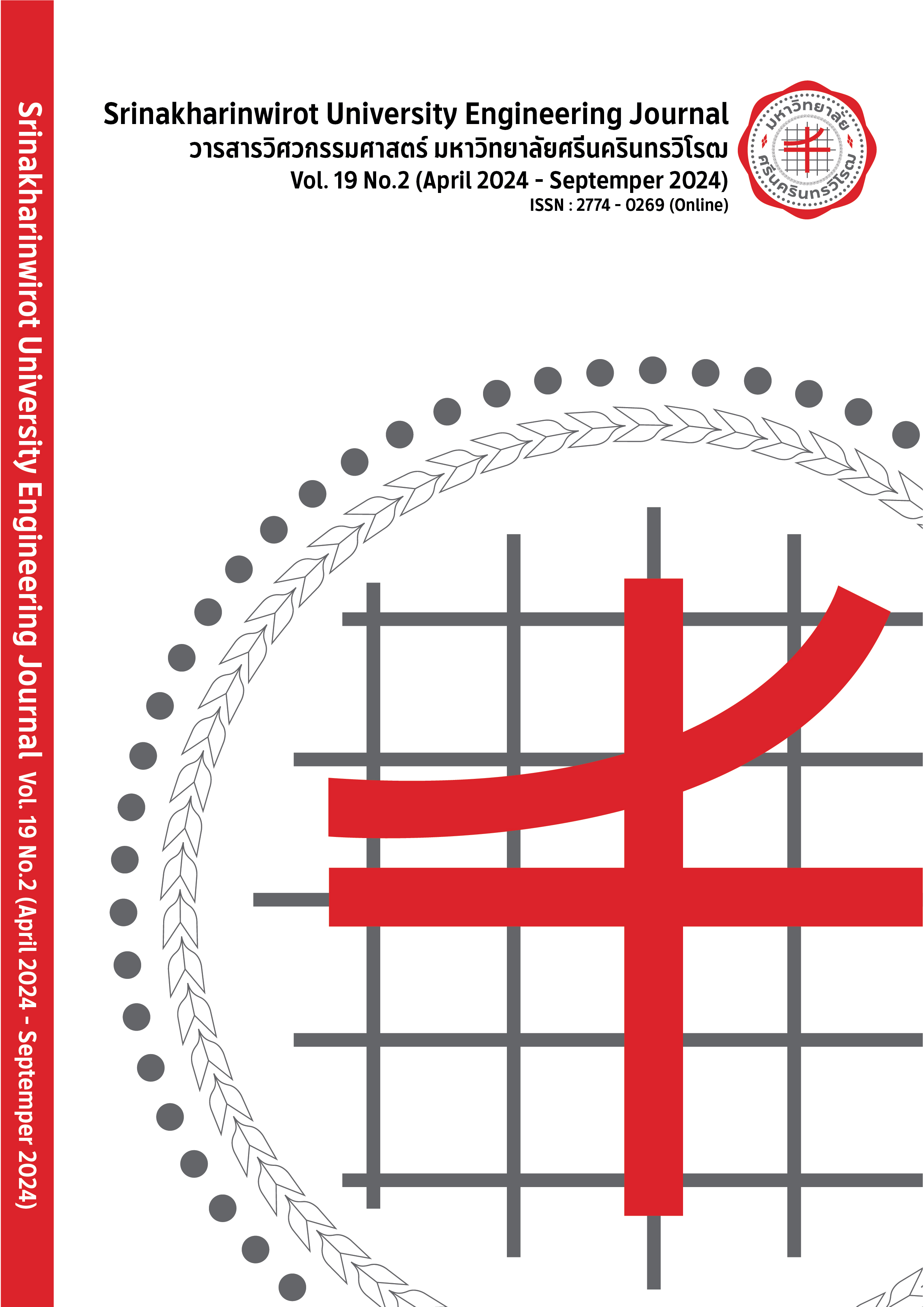Potential of Ethanol and Biogas Production from Oil Palm Frond Juice and Oil Palm Trunk Juice
Main Article Content
Abstract
This research aimed to study the potential of ethanol and biogas production from oil palm frond juice (OPFJ) and oil palm trunk juice (OPTJ) performed using S. cerevisiae for alternative energy. The amount of glucose consumed quickly to produce ethanol in 48 hrs. The amount of glucose in OPFJ decreased from 31.26 to 5.09 g/l, and OPTJ decreased from 58.65 to 4.95 g/l. The amount of glucose consumed to produce ethanol until steady-state at 96 hours of fermentation processes. The highest ethanol yield from OPTJ and OPFJ was 31.28 and 11.50 g/l, respectively. The calculation of ethanol yield found that the ethanol yield from OPTJ was higher than that of OPFJ. The ethanol yield of OPTJ was 0.48. g-ethanol/g-glucose, while OPFJ was only 0.39 g-ethanol /g-glucose due to fermentation efficiency. The fermentation efficiency of OPTJ was as high as 93.42%, while the fermentation efficiency of OPFJ was only 72.14%. Biogas production from distillery slop of OPFJ and OPTJ used the biochemical methane potential (BMP) technique. The maximum accumulated methane production of OPFJ and OPTJ were 997 and 1,068 ml at 71.53 and 71.18% of methane composition, which were very similar. Corresponding to methane yield (Yield) was equal to 314 and 336 ml CH4/g VS. The experimental results showed that OPFJ and OPTJ of distillery slop have the potential to be used as raw materials for biogas production. Three Genera of archaea dominant founding were Methanobacterium sp., Methanofollis sp., and Methanosaeta sp.
Article Details

This work is licensed under a Creative Commons Attribution-NonCommercial-NoDerivatives 4.0 International License.
Copyright belongs to Srinakharinwirot University Engineering Journal
References
R.G.J. Edyveana, W. Apiwatanapiwatb, P. Vaithanomsatb, A. Boondaengb, P. Janchaib and S. Sophonthammaphat, “The Bio-Circular Green Economy model in Thailand – A comparative Review”, Agriculture and Natural Resources, vol. 57, pp. 51-64, 2023.
M. Shafiel, M.M. Kabir, H. Zilouei, I.H. Horvath and K. Karimi, “Techno-economical study of biogas production improved by steam explosion pretreatment”, Bioresource Technology, vol. 148, pp. 53–60, 2013.
M.A.K.M. Zahari, M.R. Zakaria, H.H. Ariffin, M.N. Mokhtar, J. Salihon, Y. Shirai and M.A. Hassan, “Renewable sugars from oil palm frond juice as an alternative novel fermentation feedstock for value-added products”, Bioresource Technology, vol. 110, pp. 566–571, 2012.
M. Wasterholm, M. Hansson and A. Schnurer, “Improved biogas production from whole stillage by co-digestion with cattle manure”, Bioresource Technology, vol. 114, pp. 314-319, 2012.
I. Angelidaki and L. Ellegaard, “Co-digestion of manure and organic wastes in centralized biogas plants, status and future trends”, Appl Biochem Biotech, vol.109, pp. 95-105, 2003.
S. O-Thong, A. Hniman, P. Prasertsan and T. Imai, “Biohydrogen production from cassava starch processing wastewater by thermophilic mixed cultures”, Int J Hydrogen Energy, vol. 36, pp. 3409-3416, 2011.
K. Kongjan, S. O-Thong and I. Angelidaki, “Biohydrogen production from desugared molasses (DM) using thermophilic mixed cultures immobilized on heat treated anaerobic sludge granules”, Hydrogen energy, vol. 36, pp. 14261-14269, 2011.
E.W. Rice, R.B. Baird, A.D. Eaton and L.E. Clesperi, “Standard methods for the examination of water and wastewater (22thed).” Washington DC.: American Public Health Association, 2012.
N.H.M. Yasin, M. Furkuzaki, T. Maeda, Miyazaki, T. Miyasaki, C.M.H.C. Maail, H. Ariffin and T.K. Wood, “Biohydrogen production from oil palm frond juice and sewage sludge by a metabolically enginerred Escherichia coli strain”, International journal of hydrogen energy, vol. 38, pp. 10277-10283, 2013.
G. Reed and T.W. Nagodawithana, Yeast Technology. New York: Van Nostrand Reinhold, 1991.
S.S.S. Abdullah, Y. Shirai, E.K. Bahrin and M.A. Aassan, “Fresh oil palm frond juice as a renewable, non-food, non cellulosicand complete medium for direct bioethanol production”, Industrial Crops and Products, vol. 63, pp. 357–361, 2015.
C.L. Ramos, W.F. Duarte, A.L. Freire, D.R. Dias, E.C.A. Eleutherio and R.F. Schwan, “Evaluation of stress tolerance and fermentative behavior of indigenous Saccharomyces cerevisiae”, Brazilian Journal of Microbiology, vol. 44, pp. 935-944, 2013.
X. Wu, S. Staggenborg, J.L. Propheter, W.L. Rooney, J. Yu, D. Wang, “Features of sweet sorghum juice and their performance in ethanol fermentation”, Industrial Crops and Products, vol. 31, pp. 164-170, 2010.
M. Pavlecic, I. Vrana, K. Vibovec, P. Horvat, B. Santek, “Ethanol production from different intermediates of sugar beet processing”, Food Technology & Biotechnology, vol. 48, pp. 362-367, 2010.
Energy Research and Development Institute Nakornping, Chiang Mai University. “Biochemical methane potential (BMP) analysis document”, 2011.


